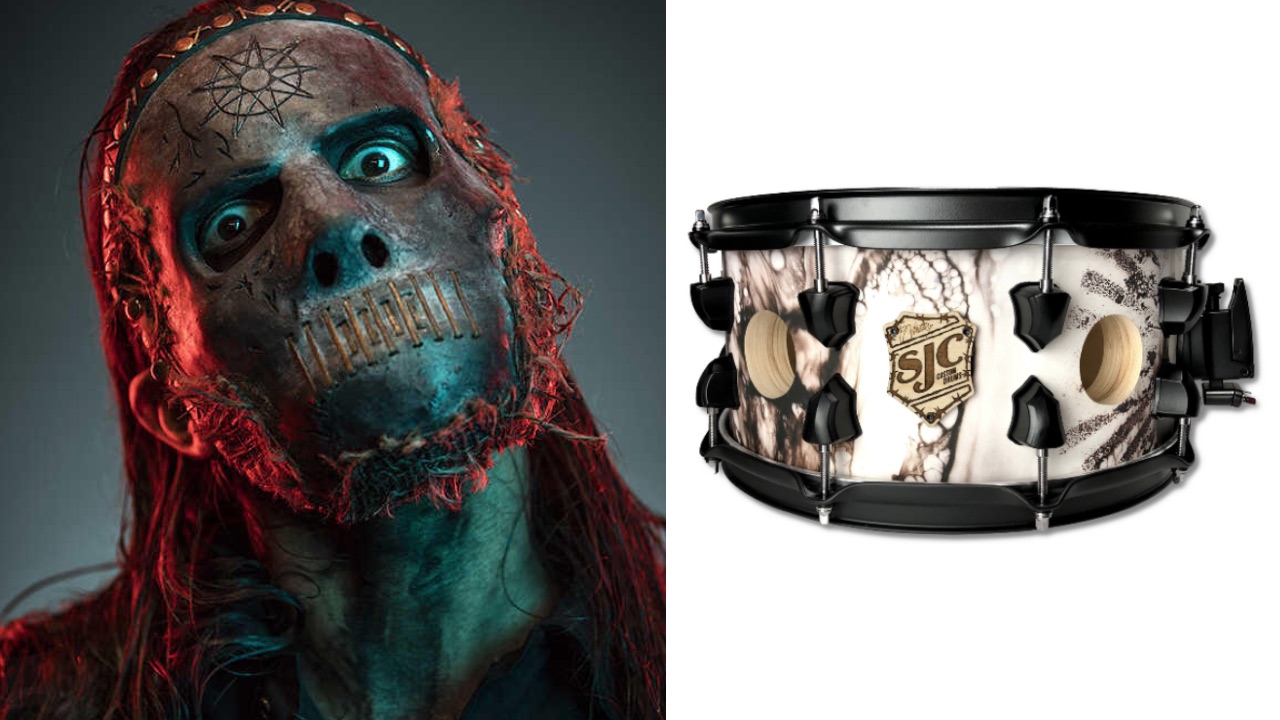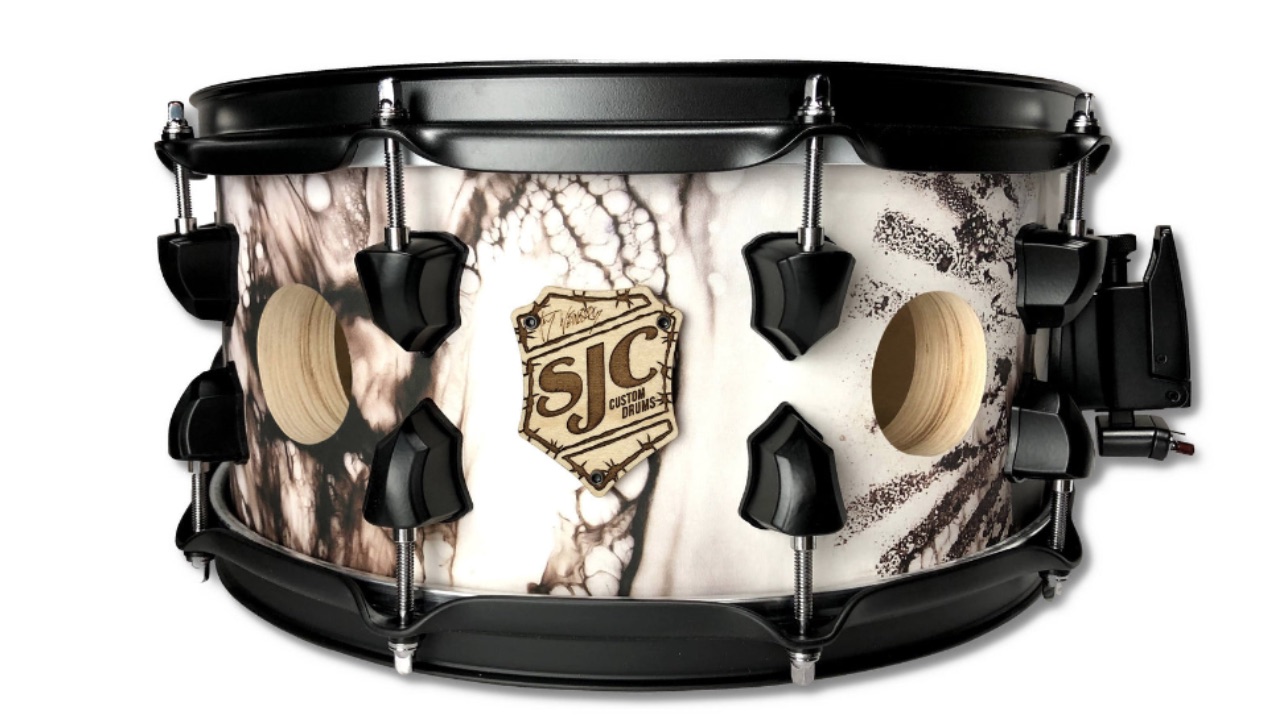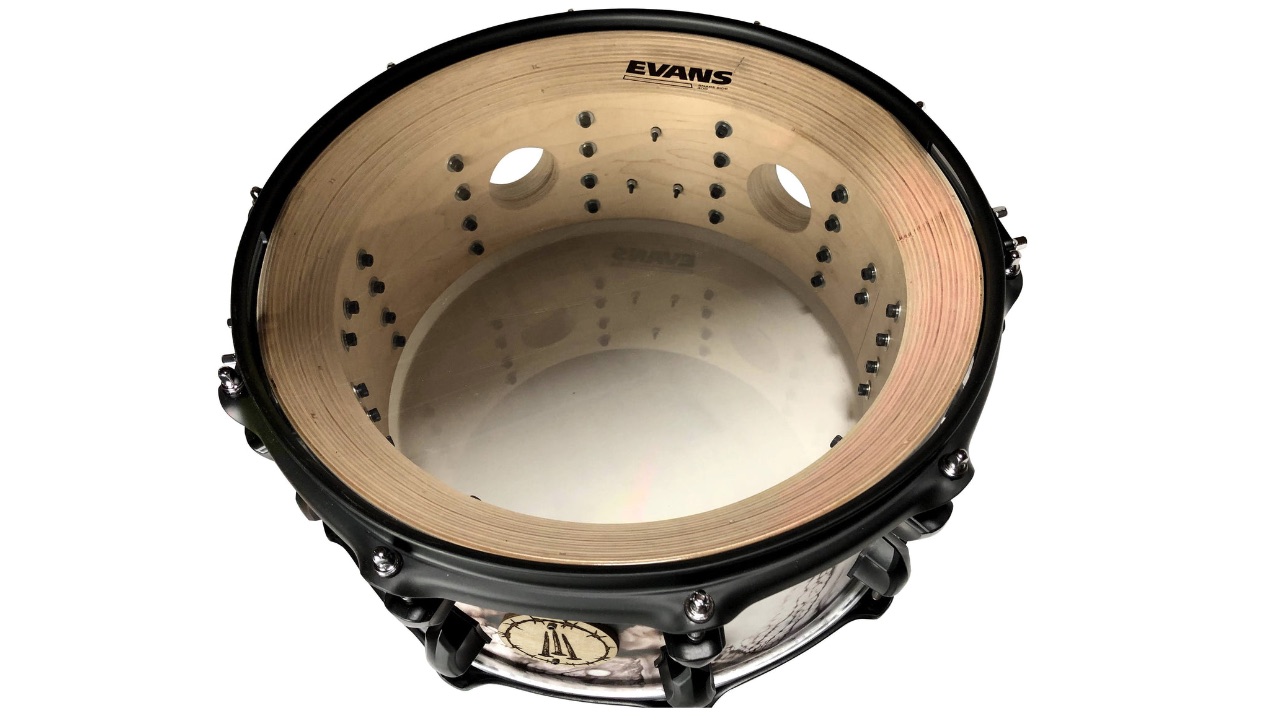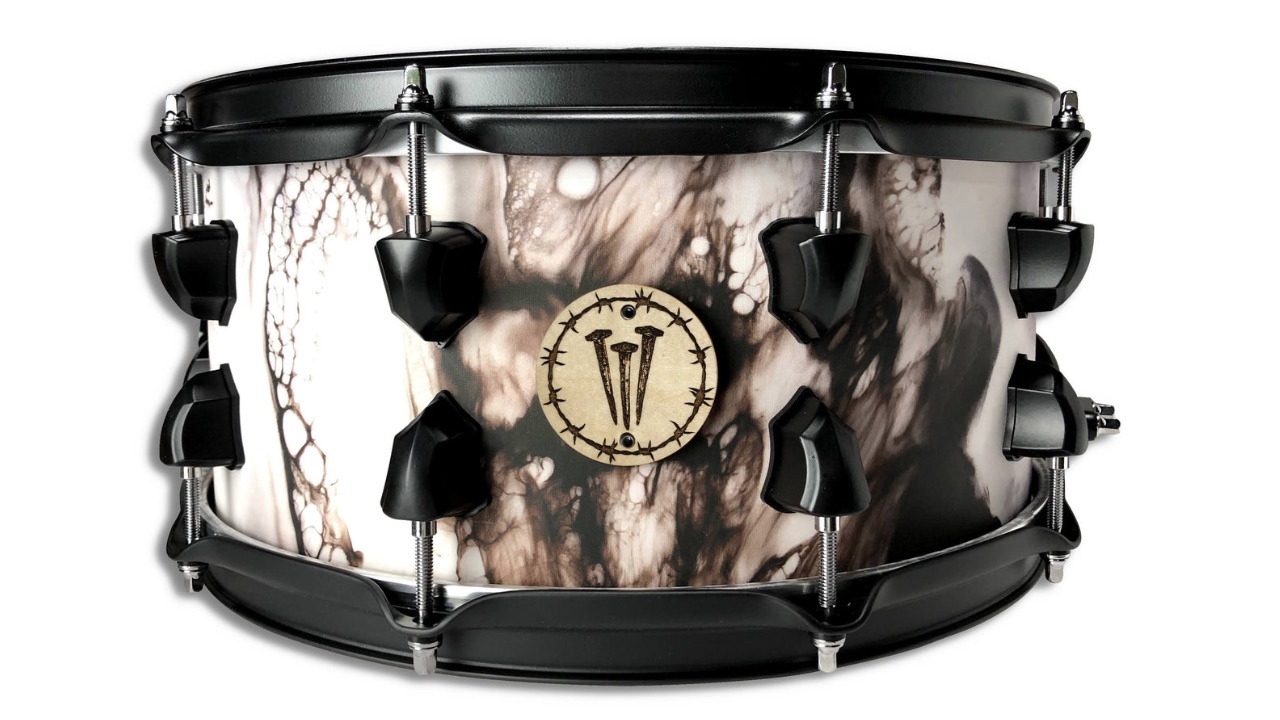Slipknot's Jay Weinberg on his SJC 48-ply, vented maple signature snare drum
This one does get loud

Playing drums for Slipknot presents some unique challenges. Not only is the whole set spent in a mask and workwear, but these songs aren’t ballads. With that considered, there’s also the not-so-small matter of being part of a nine-man juggernaut pummelling the audience while competing with a wall of low-tuned guitars, bass, synths and samples.
Jay Weinberg found this out early-on in Slipknot, “It took some time finding my footing in that arena, sonically.” he tells us. “Playing the shows was great, but I was really learning on the fly, because there was no way for me to study how to play a Slipknot show and stuff like that, you just you just learn by doing.”
What Jay is referring to is probably the polar-opposite to what many of us have experienced playing live: his snare drum, essentially wasn’t cutting-through enough.
The solution lies away from microphones and sample-reinforcement, with Jay and SJC Drums founder Mike Ciprari instead going back to the drawing board to fix the problem at source.
In this case, the source became Jay’s signature snare drum - his first with SJC. A 14”x6”, 48-ply maple monster, complete with ‘go-louder’ vents, matt black hardware and custom artwork which was not only created by Jay (who happens to be an incredible artist as well as one of the best-loved metal drummers on the planet), but saw him adopt a brand new way of making art with resin.
If you think signature drums are simply re-badged production models, this one will make you think again. We spoke to Jay to find out all about the snare’s development.

Your snare is quite different to most, where did you start when you began designing the drum?
Want all the hottest music and gear news, reviews, deals, features and more, direct to your inbox? Sign up here.
"The idea came about…it was never intended that we would make it as a signature snare available to the public and stuff but we heard enough feedback that it kind of got our interest. To backtrack a little bit, it goes back to about 2015 when I was still fairly new to touring with Slipknot and had only been playing shows for about a year.
"I had an initial drum set, which was bigger than any drum set I've ever played in my life - two bass drums and a whole mess of tom's and this and that. So with that, I got to really identify through repetition of playing shows, what I specifically wanted to change [within my kit].
"I need to blast through eight other guys in our band like a shotgun and I wasn't quite getting that out of acrylic and metal drums, like I had in the studio.
"I'd used some metal drums in the studio to make my first record with the band. So Mike and I got talking about what we could do.
"He came up with the idea of 'Hey, what if we threw it back to punk and hardcore and metal drummers we both love from the late 90s/early 2000s?' So we started talking about making a super thick-shell and having two, two-inch vents on the sides. That way, there's all this compressed air. So when you tighten it, you really get that attack, that pop and that very quick resonance.
"And so by making that really thick shell, Mike was like, 'We should do something ridiculous, like 48 plies of maple.' So it's pretty much like you're carving a little hole out of a trunk of a tree. The compressed air shoots out of the side from these events, and the volume is ridiculous. It was also important to me that all my ghost notes don't get lost, so they're amplified. I just kind of want everything to be heard, our music just kind of calls for that.
So how did that drum go from being a custom to a signature model?
"Mike made me a version of the drum back in 2015 and I fell in love with it. It was the answer to everything that I wanted without knowing how to identify that. So it became the staple snare drum, it became definitely part of my sound that I felt I was developing.
"Over the years since then, I had a lot of feedback from our audience and drummers who had come to see us and want to play on my snare drum and stuff. They were hitting up SJC, like, 'Hey, I want to get that snare drum'.
"It's difficult for for SJC, because it takes a lot of time, a lot of wood, a lot of resources to make a drum like this. And fortunately, I play SJC and SJC is like a custom shop. Everything they do in their US shop is drummers building custom drums for other drummers, so they can focus on the detail on giving drummers whatever they want.
"So a lot of people started clamouring for it, that's when Mike and I got to talking about making this drum readily available for anybody who would want to play it. We got to kick around the idea of taking the shell that he had developed and bringing in my artwork.
"It's exactly what you would find me playing live. That was important to him and to me - this is the exact drum that I'm walking up on stage to use.
"So yeah, if you're somebody who enjoys my playing or the drums that I play or whatever this is completely by design, what I play on stage, and has my hand in designing it as well with the artwork and the badges and this and that.
"We really wanted to blow the doors off for our first step forward into this, nothing has ever been done on this size of a signature to my knowledge - 48-ply maple with two-inch vents. So it was quite an endeavour to try, especially having never made a signature instrument before."
There's a lot of interesting features. Had you tried a shell that thick and vented before?
"Not before 2015, that was my first time trying a snare drum like that. It was never in my instinct, I guess, to try that because I had success with acrylic snares before that, metal snares before that.
"I suppose I hadn't necessarily been playing music that demanded such intensity. I was playing in punk rock bands and hardcore bands and stuff. I still needed the intensity and the attack, but it was more about having more body to it. Not to say that this 48-ply doesn't have the body because it certainly does.
"But with that, it was kind of more about filling in depth with a band, especially with just two guitars and a bass and vocals or something. But with so many layers of instruments around me in Slipknot, I needed to up the intensity and sort of rise above that need for depth and low end coming from my snare drum.
"This snare does have a dynamic tuning range and it does have beef to it, but really it's intended for high tuning, blasting straight through. If you ever want to play in a hockey arena and not even need to mic your snare drum, this is the snare drum that you'd want!
"But I had never really experimented with anything more than maybe 10 plies of maple. I hadn't tried the vents either. So this was like a totally new experiment that blew me away. I'd never tried anything like that before.
As you say, vented snares were popular in the late 90s/early 00s…
"Listening to drummers that I grew up loving - Travis Barker, Adrian Young [No Doubt], Chris Hornbrook [Poison The Well] - guys that use these kinds of snares and you'd see videos or pictures of them in the studio or playing on Warped Tour or something like that, I was definitely influenced by those late 90s, early 2000s records.
"So going back it was such a specific style, such a specific way of of getting a snare sound that was incessant. It was right there in your face, and I wanted something that felt like that as well.
"So Mike just cut right to the chase and was like, 'Let's make it super, super-thick. Let's give it vents and it'll be right up there.' You can't you can't hide from it. Nobody can hide from it!
Do you think the trend for triggering snare sounds in heavier music is returning to more organic sounds?
"It's a different dynamic when you're dealing with trying to make it as real as possible. We have great engineers as well, in the studio and live who can really dial-in exactly what I'm doing without having to do studio trickery to it, and sample it and stuff like that.
"When you're at our show, you're hearing 100%, my snare drum that I'm playing, for better or for worse, you're hearing exactly what it is. That's important to me to keep that organic nature of it.
"Because all of what we do with Slipknot is is 100%, organic, you're not hearing us play to anything pre recorded. We don't play along to a metronome or anything, you're hearing a completely raw band that just has a lot of elements of it, that makes it sound so full. We don't need anything that's fabricated, because we've got plenty of guys on stage to do it all, you know.
"That's very important to me, that it sounds authentic. It sounds like a person, it doesn't sound like a robot or anything like that. I understand people's needs, [drum samples] are an amazing tool when you can make a record in your bedroom, and you don't need to rent out a super-expensive studio to get great drum sounds and this and that.
"So I definitely understand the application for great drum libraries and samples of snares and stuff like that. But for us…I'm glad that I play with a group of guys where that was never in their playbook. They were a band that started in 1995. Their favourite bands were bands that never had access to anything other than making records that were human.
"The drum lends itself to that. You're not going to need to remove this human element out of it, you're not going to need to sample it or whatever. It's right there. It's in your face."

Could you talk us through the artwork?
"I came up with a specific design for the snare. It was a proprietary piece that I made that was a different experimentation. Usually I paint with oils, but then I also take inspiration from a lot of more experimental artists who do kind of crazy abstract watercolour, ink and spray-paint stuff. So I wanted to try something that I had never done before, which is working with resin.
"I kind of became a little bit fascinated with resin artwork that at the beginning of quarantine, like 'Alright, what can I do to stay busy and just stay in my house and make art?'.
"So I started experimenting with resin, which is super interesting, you take all these pigments and you just kind of insert them into molten resin and you just need to heat it up and, and massage it in certain ways so that the pigment just kind of has a mind of its own. It stretches out the way it wants to. It makes this kind of spiderweb-look with cells.
"When I was coming up with artwork for what I would do for a snare drum, it was difficult because I was like, 'Well, I could paint figures of things' but nothing I was coming up with was looking right.
"I'd paint a person on the drum and it would just look weird, stretched out over this cylinder. So I decided to keep it in the more abstract realm. I've painted drums for SJC before too. I'd probably done 20 or so individually painted snare drums by that point where I was actually painting on the surface of the shell, which is really difficult because it's hard to balance watercolour on a curved surface.
"Those snares are scattered throughout the world, I don't know where they've gone, but people have them. So yeah, I came up with a bunch of designs, and just settled on the one that I felt was really great.
"I came up with that with the intent of this artwork being paired with black hardware. It's is pretty much black and white, it's got some other tones in it, but it's primarily black and white, because I wanted it to go with any drum set, visually.
"So that was kind of my mentality going into the project of designing the artwork, I wanted it to be expressive and have my hand in it. I designed the badge as well - the W 'Nails' icon."

Are the badges cut by a laser?
Yeah, directly on to wood. Each of the snares have that custom icon badge, and then the SJC badge that has my signature on it too. All those are custom cut and engraved.
If I'm ever going to do something that's a signature product of mine. I want it to have my handprint all over it, you know, whatever it is, if it's my sticks, or my snare drum, or anything I do in the future, it's important to me that everything kind of comes from the person themselves, you know?
"If I'm somebody who's getting a signature pair of drumsticks or a signature snare from somebody, I don't want it to be something that somebody else came up with, and they just slap my name on it.
"I really want to be very heavily involved in the process of making it because it's an extension of me, it's an extension of the sound that I hear in my head. And so the fact that anybody would want to play on one is is really rad. And with that in mind, I kind of want to just immerse myself in making it as personal as I can.
You mentioned already that you tune the drum quite tight, could you tell us a bit more about the heads and tuning you use?
"I use an Evans Heavyweight 360 head. It's incredible. I started playing Evans heads in late 2015. And, and that was the first head that I was just like, 'Oh, man, this is totally dialled in to what I want to use.' And I love that thing. It's got a lot of body, but a lot of crack and high end that I love.
"I just crank it, that's really all there is to it. There is nuance of how I tune it, and making sure it's not choking out completely. You don't want to just have something that's like an unexpressive splat.
"But having it tuned to where it captures the lively nature of a really thick shell like that, I feel it's best suited to when you're tuning the top and the bottom head relatively tight.
"I tune the resonant head a little bit looser than the top head, but they're pretty evenly matched. There is a lot of air in there, so I have on occasion busted through the bottom head, because you're just whacking it. With both heads very tight, sometimes it leads to the bottom head just going out. It's a trade hazard!
"I really like it tuned high with a head like the Heavyweight, or anything that has that kind of dot on the bottom of the head. I like playing with snare heads that have that focus that the Heavyweight has, and I played other snare drum heads that have that controlled sound, sort of thing. I find it gets the quick resonance, that super-fast gunshot. Our music really dictates that, and it really needs that.
"More-so in the live setting than in the studio. I tend to do like more of a mid/high tuning, maybe allowing for a little bit more of a low end-y growl. When it's live, and you're dealing with so much happening at one time, I do want it to just shoot across from the stage to the back of the room.
"So that's when tuning higher has to happen and I think it also helps my bandmates as well. They're wanting to hear that snare consistently from wherever they're standing and moving around the stage.
"It's just the gunshot that they're locking into with their guitars or keyboards or vocals or whatever. It's a real hard rock/heavy metal band's snare drum. This thing keeps everything everybody locked in on that downbeat. That's super important to me and us."

Stuart has been working for guitar publications since 2008, beginning his career as Reviews Editor for Total Guitar before becoming Editor for six years. During this time, he and the team brought the magazine into the modern age with digital editions, a Youtube channel and the Apple chart-bothering Total Guitar Podcast. Stuart has also served as a freelance writer for Guitar World, Guitarist and MusicRadar reviewing hundreds of products spanning everything from acoustic guitars to valve amps, modelers and plugins. When not spouting his opinions on the best new gear, Stuart has been reminded on many occasions that the 'never meet your heroes' rule is entirely wrong, clocking-up interviews with the likes of Eddie Van Halen, Foo Fighters, Green Day and many, many more.